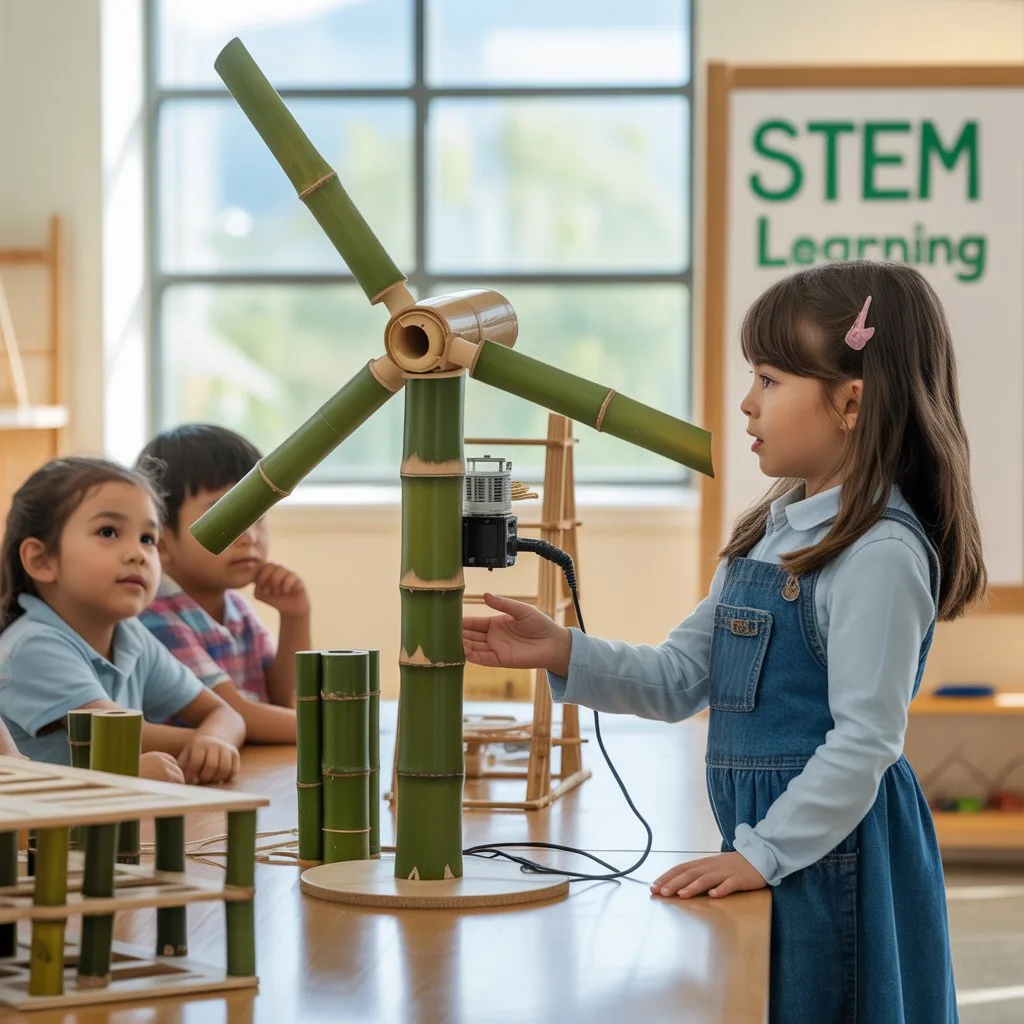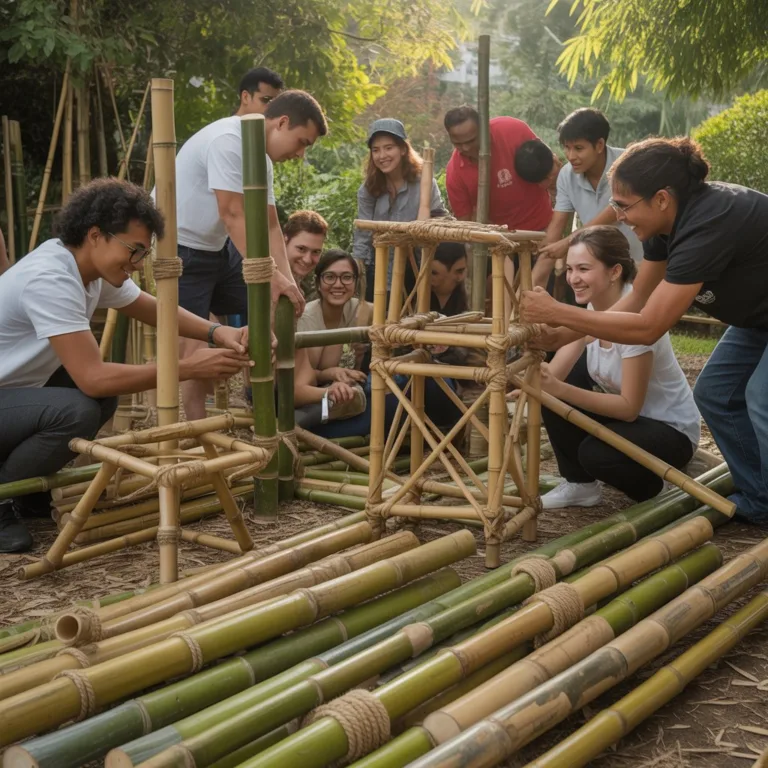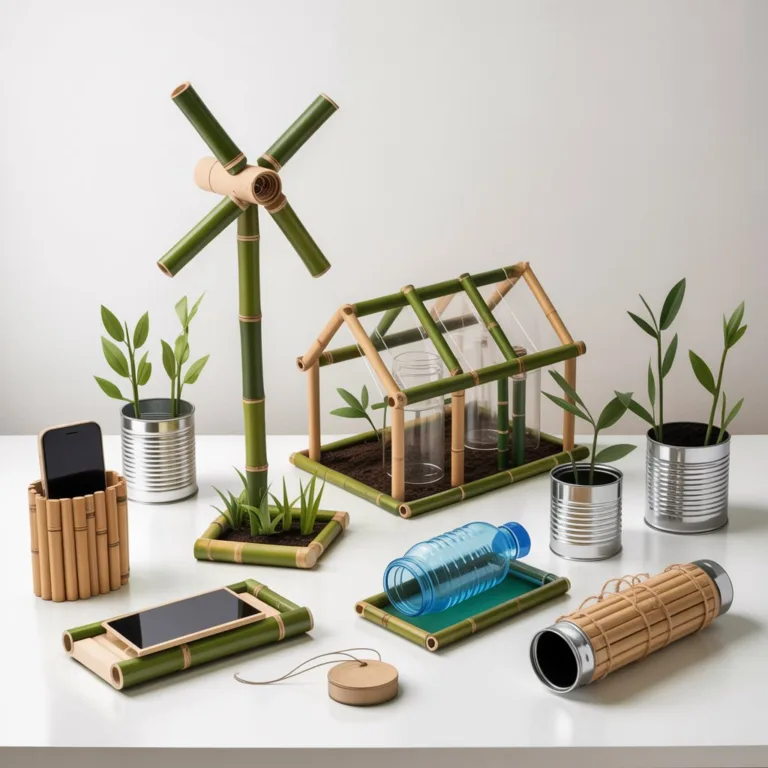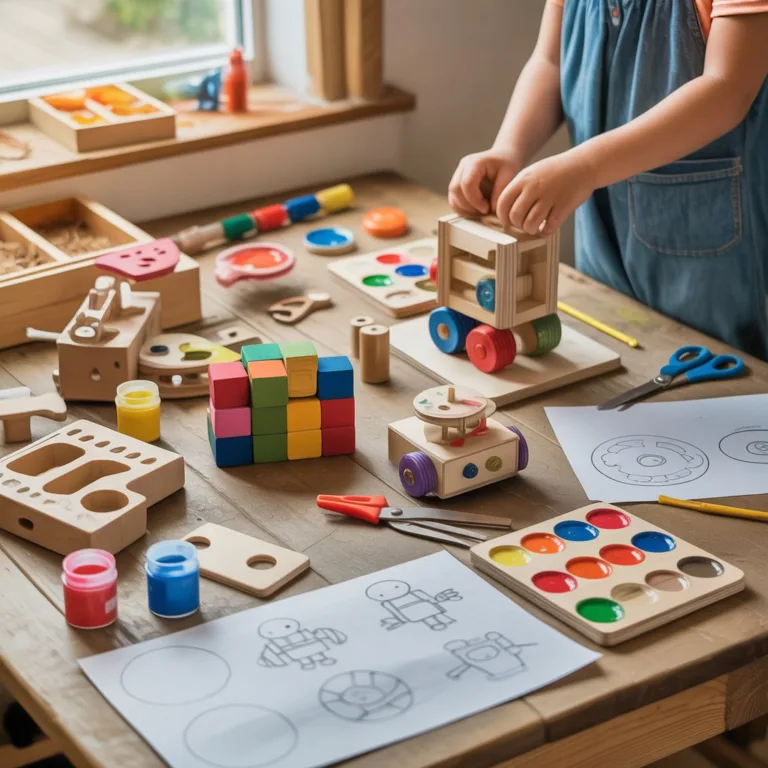In classrooms, workshops, and homes around the world, educators are rethinking how to inspire creativity while fostering environmental awareness. One of the most engaging ways to do this is through teaching STEM concepts with recycled bamboo projects. By blending science, technology, engineering, and math with sustainability and hands-on creativity, bamboo crafts transform simple materials into powerful learning tools.

Whether you’re a teacher looking for innovative classroom activities or a parent eager to nurture curiosity at home, bamboo-based STEM projects offer endless opportunities. They connect lessons about mechanics, biology, and physics with real-world applications — all while encouraging resourcefulness and respect for the environment.
The Intersection of STEM and Sustainability
STEM education aims to build critical thinkers — people who can analyze problems, design solutions, and understand how the world works. But when sustainability is added into the mix, the result becomes even more meaningful. Students not only learn how things work, but also why it matters to make choices that protect the planet.
Using recycled bamboo in STEM activities reinforces this connection beautifully. It’s hands-on science with a purpose: learning how materials behave, testing engineering principles, and reducing waste simultaneously.
Why Bamboo is Ideal for STEM Learning
Bamboo isn’t just a plant; it’s nature’s engineering marvel. It grows faster than almost any other renewable resource, sometimes shooting up over a meter in a single day. Structurally, it’s both lightweight and incredibly strong — properties that make it a fascinating subject for study and experimentation.
In a STEM context, bamboo allows exploration of:
- Physics: force, motion, balance, and energy transfer.
- Engineering: design, stability, and materials testing.
- Mathematics: measurement, geometry, and scaling.
- Environmental science: ecosystems, growth cycles, and renewable resources.
Combining these elements through recycled bamboo projects gives students tangible, memorable experiences that extend far beyond the textbook.
Understanding Bamboo as a Natural Material
Before diving into projects, it’s important for learners to understand what makes bamboo unique. This context transforms a simple crafting session into an exploration of science and nature.
The Science Behind Bamboo
Bamboo belongs to the grass family but has characteristics more similar to wood. Its hollow structure gives it an excellent strength-to-weight ratio, and its internal fibers make it flexible yet durable.
These properties can lead to fascinating classroom experiments. Students can test how much weight different bamboo pieces can hold or how cutting the stalk at different points changes its flexibility.
Bamboo also provides an introduction to biomimicry — designing materials and systems inspired by nature. For instance, studying how bamboo grows and distributes stress can inform how students design bridges, towers, or toy vehicles using recycled materials.
The Environmental Edge
From an ecological standpoint, bamboo’s sustainability is unmatched. It regenerates quickly, requires minimal water, and thrives without chemical fertilizers or pesticides. When students reuse bamboo from old furniture, chopsticks, or craft scraps, they experience a circular approach to resources — one that turns waste into opportunity.
Discussing bamboo’s carbon absorption and soil-protecting properties introduces key environmental science concepts. It’s a simple yet effective way to show that materials science and environmental stewardship go hand in hand.
Preparing for Recycled Bamboo STEM Projects
Before teaching STEM concepts with recycled bamboo projects, preparation ensures safety, learning efficiency, and creativity.
Collecting and Cleaning Materials
Recycling starts with gathering. Encourage students to look for bamboo scraps at home or in their community. Common sources include:
- Old bamboo blinds or mats
- Discarded garden stakes
- Broken bamboo furniture
- Leftover pieces from craft or construction projects
Once collected, clean the bamboo thoroughly. Rinse with water and let it dry naturally. If necessary, lightly sand rough edges to make it safe for handling. This process itself becomes a lesson on material preparation and recycling practices.
Tools and Supplies
Depending on the project, simple hand tools are often enough. These may include:
- Small saws or cutters
- Sandpaper
- String or biodegradable twine
- Non-toxic glue
- Recycled plastic caps, cardboard, or bottle tops for added parts
Encouraging tool safety and responsibility is an important part of any STEM lesson. Students can discuss how to minimize waste and safely reuse materials while creating their projects.
Engaging Bamboo Projects That Teach STEM Concepts
The beauty of recycled bamboo is that it adapts to countless creative projects, from simple classroom experiments to advanced engineering challenges. Below are examples that demonstrate how to teach key STEM principles using accessible materials.
Bamboo Bridges: Exploring Engineering and Physics
Building bridges from recycled bamboo introduces students to engineering design and physics concepts like load distribution, compression, and tension.
Start by having students design a bridge that can span a small gap — such as between two desks — using only bamboo sticks, string, and glue. They can test how much weight their bridges hold before bending or breaking.
This activity promotes teamwork, problem-solving, and iterative design. It also helps students understand the real-world applications of engineering principles in sustainable construction.
Bamboo Windmills: Learning About Renewable Energy
Wind energy becomes a tangible concept when students construct miniature windmills using bamboo stems for structure and recycled paper or plastic for blades.
Through this activity, learners explore:
- Energy conversion: from wind to mechanical energy.
- Aerodynamics: how blade angles affect rotation speed.
- Environmental science: how renewable energy compares to fossil fuels.
Testing these windmills outdoors or with a fan allows for data collection and graphing — perfect for integrating math and science. Students can measure rotation rates, compare designs, and analyze which configurations perform best.
Bamboo Water Wheels: Understanding Motion and Hydropower
A bamboo water wheel is an exciting way to combine physics, engineering, and environmental education. Using small bamboo tubes as paddles attached to a central axle (perhaps from an old pen or wooden skewer), students can design wheels that turn when water flows over them.
This simple project illustrates:
- The concept of kinetic energy transforming into mechanical energy.
- How ancient technologies inspired modern renewable power systems.
- The physics of torque and balance.
Connecting this experiment to real-world examples like hydroelectric dams gives students a broader understanding of sustainable energy systems.
Bamboo Toy Cars: Applying Motion and Mechanics
When learners build toy cars from recycled bamboo and bottle caps, they explore friction, balance, and energy transfer in a playful context.
Each decision — from wheel placement to axle length — affects how smoothly the car moves. Teachers can turn this into a data-driven experiment: students modify designs and measure how far each car travels when pushed with equal force.
The best part? Every car tells a story of ingenuity and sustainability, proving that scientific discovery can go hand in hand with creativity and environmental care.
Bamboo Musical Instruments: The Science of Sound
Sound waves come alive through bamboo flutes, xylophones, or simple shakers. Students learn how length, diameter, and air flow influence pitch and tone.
A small flute crafted from recycled bamboo becomes a physics lab in itself — showing how resonance and frequency interact. By experimenting with hole placement and tube size, learners apply mathematical reasoning in an artistic way.
This intersection of music, science, and sustainability nurtures a holistic understanding of STEM that appeals to both analytical and creative minds.
Integrating Math and Data Collection
Every recycled bamboo project offers opportunities to integrate mathematics — not as a separate subject, but as a natural part of design and experimentation.
Students can:
- Measure and calculate lengths, diameters, and angles of bamboo pieces.
- Record and analyze data on speed, rotation, or strength in experiments.
- Graph results to visualize patterns and make predictions.
For instance, when testing bridge designs, students might chart how changing bamboo diameter affects load capacity. When building windmills, they can compare how blade shapes impact energy output.
These math applications reinforce the principle that data drives design — a core idea in both STEM education and real-world engineering.
Encouraging Inquiry and Critical Thinking
The most powerful aspect of teaching STEM concepts with recycled bamboo projects is how naturally it promotes inquiry-based learning. Instead of memorizing facts, students ask questions, test ideas, and reflect on outcomes.
Teachers can guide discussions with open-ended prompts such as:
- What did you notice about how the material behaves?
- How could you make your design stronger or more efficient?
- What environmental benefits come from using bamboo instead of plastic or metal?
These discussions encourage students to think critically, make evidence-based conclusions, and understand the interconnectedness of science and sustainability.
Connecting Projects to Real-World STEM Fields
Recycled bamboo activities bridge the gap between classroom lessons and real-world careers. They highlight how sustainable design influences engineering, product development, and architecture.
Students can explore fields like:
- Civil Engineering: studying bamboo’s role in eco-friendly construction.
- Mechanical Engineering: testing material properties and energy transfer.
- Environmental Science: understanding renewable resources and waste reduction.
- Design and Architecture: creating sustainable, aesthetic solutions using natural materials.
By connecting classroom learning to potential careers, teachers inspire students to see STEM as a pathway to meaningful impact in the world.
Collaboration and Community Impact
Bamboo STEM projects also encourage collaboration beyond the classroom. Schools can organize exhibitions, eco-fairs, or recycling drives to collect materials. Communities benefit as students share their creations and teach others about sustainability.
Collaborative projects — such as building a large bamboo sculpture or a community garden structure — combine engineering skills with social responsibility. This transforms STEM education into a tool for community engagement and environmental advocacy.
Tips for Successful Implementation
To make the most of teaching STEM with recycled bamboo projects, a few practical guidelines ensure both learning depth and enjoyment:
- Start simple, then expand: Begin with easy builds like windmills or cars, then move to complex ones like bridges or instruments.
- Encourage experimentation: Allow students to modify designs and test multiple versions.
- Promote documentation: Have learners sketch ideas, note measurements, and record observations.
- Integrate reflection: Discuss what worked, what didn’t, and what could improve next time.
- Celebrate creativity: Every project, successful or not, represents learning in action.
The process itself — not just the outcome — is where the most valuable lessons emerge.
The Transformative Power of Hands-On Learning
When students work with their hands, they engage more deeply. Recycled bamboo projects turn abstract STEM principles into tangible experiences, and sustainability from a concept into a lifestyle.
Building, testing, and improving bamboo creations teaches perseverance, adaptability, and creative thinking — qualities essential for success in science and life. It also reinforces the belief that innovation doesn’t require expensive materials; it thrives on imagination and awareness.
Educators who bring bamboo-based STEM projects into their lessons often report greater student enthusiasm, collaboration, and long-term retention of concepts. The combination of natural materials and purposeful creativity transforms classrooms into living laboratories of sustainability and discovery.
So the next time you’re planning a science fair, a weekend craft, or a classroom challenge, consider the humble bamboo. Within its hollow stems lie lessons in physics, math, and ecology — and the potential to shape curious minds into thoughtful innovators.

Elena Mora is a creative educator and eco-craft enthusiast who specializes in bamboo musical instruments and sustainable toys for children. She believes that hands-on learning through play teaches kids about creativity, music, and environmental responsibility.



